To wet or not?
- Thread starter beekeeper
- Start date
You are using an out of date browser. It may not display this or other websites correctly.
You should upgrade or use an alternative browser.
You should upgrade or use an alternative browser.
NO....... You are mistaken ........ Ha ,Ha ... See I do read what is being posted. 8)
I went in here and did a little editing to keep this thread on it's original thought. After all this is the Serious Section and it was getting derailed. :roll:
I went in here and did a little editing to keep this thread on it's original thought. After all this is the Serious Section and it was getting derailed. :roll:
tx river rat said:I dont wet ply
bit nearly all my boats have some solid wood on them.
We all have our way to do our builds and mine is just my way ,and most of the builders I know personally.
As far as brad are naill holes opening back up , it doesn't happen ,when you have a couple extra strips try it .
Ron
OK ,I did.
1. A brad, a staple, and 3 size nails
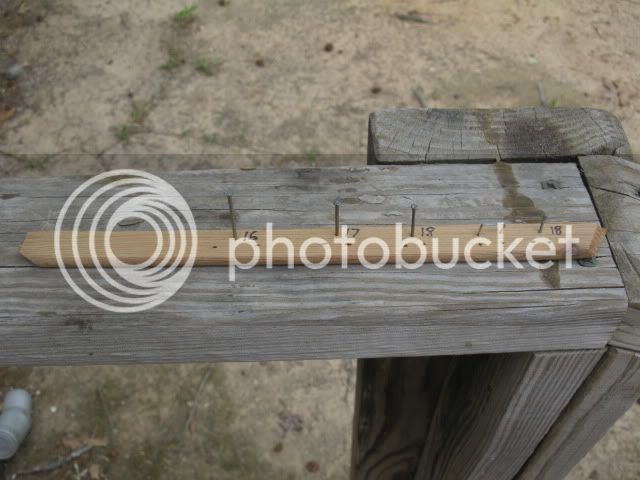
2. Soaked the wood for30 min.
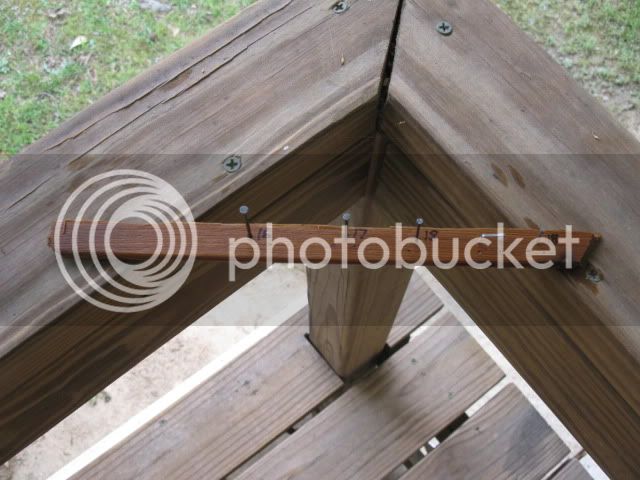
3. After 2hrs.
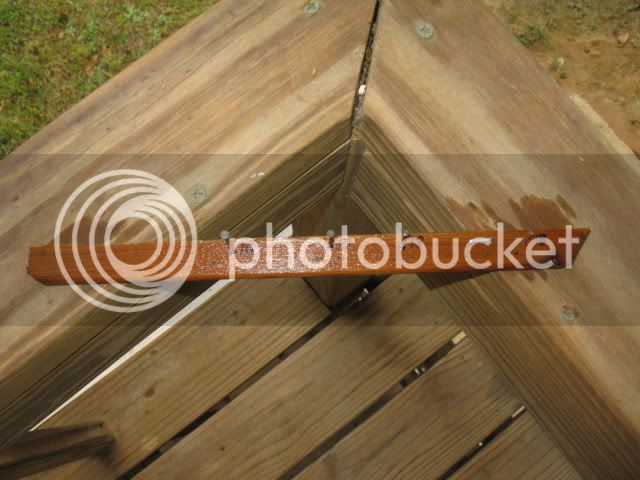
4.Soaked overnight
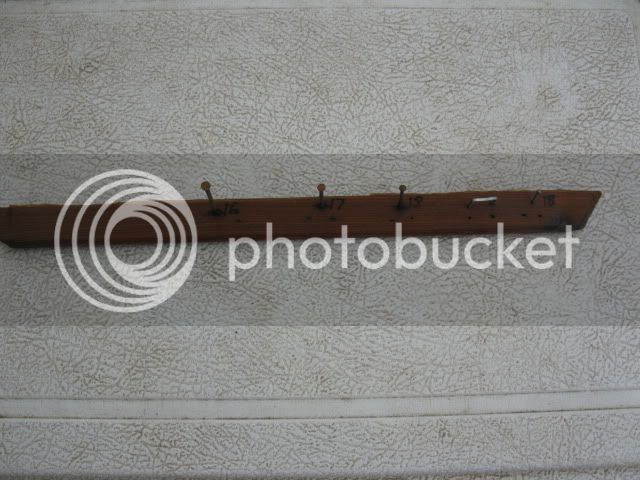
5. Dried 24hrs. + and sanded 220 grit
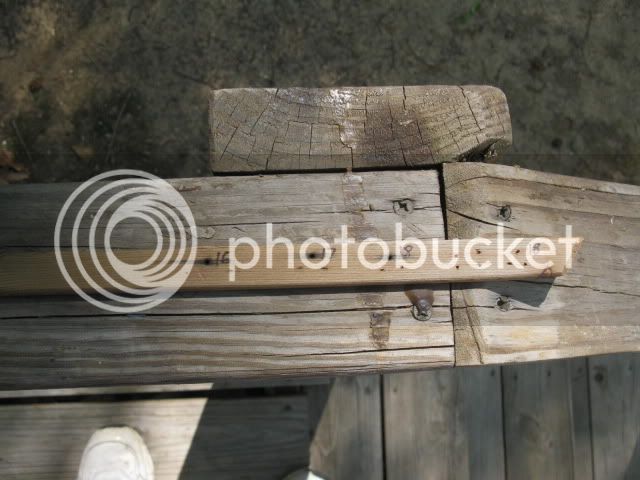
6. Two coats of epoxy.
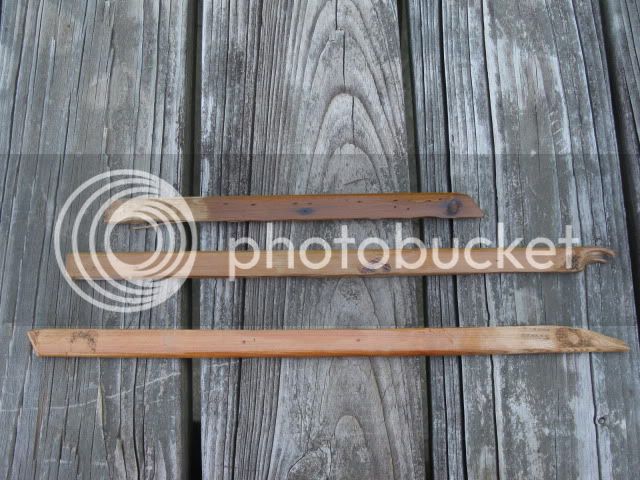
7. Holes not closed after soaking
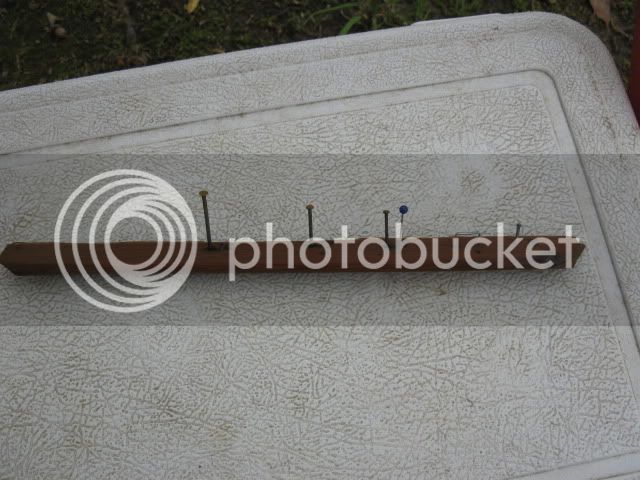
Turning into too much typing. Metered a strip = 5% moisture, soaked overnight = 16%, dried 24hrs. = 5%
Soaking the strips raises the fibers on the surface partially concealing the holes. The holes did not close competly. Some of the raised fibers were sanded away exposing the hole agin. The saturation coat of epoxy applied to nonwetted strips did as good a job disguising the hole as soaking did. Bottom board in picture # 6 is the epoxy only.
It apears the wetting leaves no extra moisture wth proper drying and that while not harmfull wetting may be unnecesary. The epoxy seemed to disguised the holes just as well.
beekeeper
tx river rat said:how thick were the strips you were using, and what kind of wood.
?
Ron
1/4" thick, western red cedar, left overs from my strip pirogue
beekeeper
tx river rat said:Ok now do it multiple times and go back and note we also used hot water at times.
Ron
Nope.
The results are what they are. Running more test to find results to match your ideas will not change that these conclusions were not what you expected. None of this post was intended to say you, or anybody else was wrong. The first question I stated was putting forth an idea of why Darrells glass turned loose, an attempt to help, not dispute anybody's build methods. The other questions and ideas were to learn. You suggested I try this on some extra strips. Do what you want with the answers.
The test was valid and represented all the factors you disscused. Thoroughly soaking the wood, nail/brad holes, raising the grain/closeing the holes, completly drying the wood, checking the moisture content with a meter, sanding the wood, saturating with epoxy.
The test did show that soaked wood will dry and return to kiln dried levels. My suggested theory, and ideas were dispelled. Good information to know. The grain/wiskers were raised after the wood was soaked and that did partiality disguised the holes. The holes were not sealed closed. They were also raised on the board that was epoxy saturated only. This would suggest you could skip the water soaking step. That would be good information to know.
Note; The strip was soaked for 24 hrs. (much longer than a boat is) and the hot water was replenished several times.
The whole matter is realy irrelevant, because strip boats can be constructed without nail/brad/staple holes.
beekeeper
Beekeeper is right Ron.beekeeper said:tx river rat said:Ok now do it multiple times and go back and note we also used hot water at times.
Ron
Nope.
The results are what they are. Running more test to find results to match your ideas will not change that these conclusions were not what you expected. None of this post was intended to say you, or anybody else was wrong. The first question I stated was putting forth an idea of why Darrells glass turned loose, an attempt to help, not dispute anybody's build methods. The other questions and ideas were to learn. You suggested I try this on some extra strips. Do what you want with the answers.
The test was valid and represented all the factors you disscused. Thoroughly soaking the wood, nail/brad holes, raising the grain/closeing the holes, completly drying the wood, checking the moisture content with a meter, sanding the wood, saturating with epoxy.
The test did show that soaked wood will dry and return to kiln dried levels. My suggested theory, and ideas were dispelled. Good information to know. The grain/wiskers were raised after the wood was soaked and that did partiality disguised the holes. The holes were not sealed closed. They were also raised on the board that was epoxy saturated only. This would suggest you could skip the water soaking step. That would be good information to know.
Note; The strip was soaked for 24 hrs. (much longer than a boat is) and the hot water was replenished several times.
The whole matter is realy irrelevant, because strip boats can be constructed without nail/brad/staple holes.beekeeper
No Holes
Beekeeper
You are missing half the story,and just have half the information.
If you have a dent in wood you need to raise, or a crack in wood the different methods are handy to know.
I have done some stappless building and want do it on my builds , just not worth it to me.Like Swampwood and I discussed my priorities and your are different. I think full stripers are awesome but I can get nearly the same shape without the strongback and all the hasel that goes with it , using the build method I use.I like building boats but I would rather be paddling.
Just a little back ground on the wet wood deal , I like to build stuff and have always done a lot of off the wall projects.I started learning about the wet , method of working wood when I was building native wood bows, I can take the twist out of wood shape it and make it hold its shape
all with hot water, heat and steam, did some recurve bows from different woods ,now there is some playing. Done furniture bent rockers for chairs. My point is this isnt my first rodeo on the wood and shaping and getting the best finish.
Plus on the boat building I am lucky enough to have folks around close that are awesome boat builder , a couple that are racers, . They have forgotten more than I will ever know
about handling the wood, I pay attention to folks that have 40 or 50 years experience and have a hundred boats under there belt.
I am going paddling tomorrow with a sil and introducing a young man to yaks for the first time , now that is getting down to the important stuff for me :lol: :lol:
Ron
I am glad you ran the test but remember one thing , every piece of wood will react differently to stresses , water,bending shrinking and swelling and strength of the wood
You are missing half the story,and just have half the information.
If you have a dent in wood you need to raise, or a crack in wood the different methods are handy to know.
I have done some stappless building and want do it on my builds , just not worth it to me.Like Swampwood and I discussed my priorities and your are different. I think full stripers are awesome but I can get nearly the same shape without the strongback and all the hasel that goes with it , using the build method I use.I like building boats but I would rather be paddling.
Just a little back ground on the wet wood deal , I like to build stuff and have always done a lot of off the wall projects.I started learning about the wet , method of working wood when I was building native wood bows, I can take the twist out of wood shape it and make it hold its shape
all with hot water, heat and steam, did some recurve bows from different woods ,now there is some playing. Done furniture bent rockers for chairs. My point is this isnt my first rodeo on the wood and shaping and getting the best finish.
Plus on the boat building I am lucky enough to have folks around close that are awesome boat builder , a couple that are racers, . They have forgotten more than I will ever know
about handling the wood, I pay attention to folks that have 40 or 50 years experience and have a hundred boats under there belt.
I am going paddling tomorrow with a sil and introducing a young man to yaks for the first time , now that is getting down to the important stuff for me :lol: :lol:
Ron
I am glad you ran the test but remember one thing , every piece of wood will react differently to stresses , water,bending shrinking and swelling and strength of the wood
Uh, supposed to remove the nails, staples, brads, etc., before wetting...correct? :?:beekeeper said:tx river rat said:I dont wet ply
bit nearly all my boats have some solid wood on them.
We all have our way to do our builds and mine is just my way ,and most of the builders I know personally.
As far as brad are naill holes opening back up , it doesn't happen ,when you have a couple extra strips try it .
Ron
2. Soaked the wood for30 min.

beekeeper
Least, that's the way I do it. Holes generally close up pretty well.
WDrmTN
Please look at picture #1. There are two holes below each nail. These were the test holes. I left the nail to show the size of the holes.

The holes were less visable when the wood was wet, but after drying and a light sanding not so hidden. Picture #5.

There were three questions raised, or ideas put forth about wetting and soaking the wood.
1.I was concerned the wood would retain moisture. It did not. The meter indicated it returned to the same level. Without a meter I don't know how you would know how long to dry. I left the strip outside for 2 days in the sunshine but cool weather 72 to 78 degrees.
2.Wetting would raise the grain and fibers. This would hide the holes, and allow for a smother finish after sanding the raised fibers(wiskers). Wetting the wood with water does raise the wiskers so the sanding can remove them. This gives the wood a smooth finish, but it also removed some of the fibers that covered the holes.
3.Soak the wood and the holes will close and not open agin. The holes never closed completly. They were tighter while wet and may have not returned to their original diameter, but they are still there. The broken fibers don't grow back together.
I have not built a strip boat useing nails to hold the strips in place. I used the "stapleless" method. It did not seem like more work to me. I had no nails to remove or try to hide. If the builder is satisfied with the holes and considers the "stapleless" method not worth the effort, that is fine. Every boat is a compromise.
A side note to this was the epoxy applied to a dry strip did a good job of disguising the holes. This could eliminate the step of soaking. The builder would have to decide.
beekeeper
Please look at picture #1. There are two holes below each nail. These were the test holes. I left the nail to show the size of the holes.

The holes were less visable when the wood was wet, but after drying and a light sanding not so hidden. Picture #5.

There were three questions raised, or ideas put forth about wetting and soaking the wood.
1.I was concerned the wood would retain moisture. It did not. The meter indicated it returned to the same level. Without a meter I don't know how you would know how long to dry. I left the strip outside for 2 days in the sunshine but cool weather 72 to 78 degrees.
2.Wetting would raise the grain and fibers. This would hide the holes, and allow for a smother finish after sanding the raised fibers(wiskers). Wetting the wood with water does raise the wiskers so the sanding can remove them. This gives the wood a smooth finish, but it also removed some of the fibers that covered the holes.
3.Soak the wood and the holes will close and not open agin. The holes never closed completly. They were tighter while wet and may have not returned to their original diameter, but they are still there. The broken fibers don't grow back together.
I have not built a strip boat useing nails to hold the strips in place. I used the "stapleless" method. It did not seem like more work to me. I had no nails to remove or try to hide. If the builder is satisfied with the holes and considers the "stapleless" method not worth the effort, that is fine. Every boat is a compromise.
A side note to this was the epoxy applied to a dry strip did a good job of disguising the holes. This could eliminate the step of soaking. The builder would have to decide.
beekeeper
Beekeeper
You ask a question about why wet wood and the statement that you believed it would retain moisture.You found I told you the truth.
In the conversation the fiber raising and getting a smoother finish. you found it did raise the fibers,you also found that the epoxy raised the fibers.
It did help to close the nail holes.
First I never said that the holes would heal up.
You decided to run one test on your own and then made the statements you made, now here is the rest of the story, you dont soak the wood for twenty four hours , you do it until the wood is saturated then let it dry and do it again most of the time at least three times. if you get really stubborn places heat some water and do it again.
The same goes for the sanding of the fibers that stand up the more times you wet the slicker the finish, finally they will be no more torn fibers to stand up . The smoother the finish the smoother the epoxy goes on and I sure as heck would rather sand dry wood than dry epoxy.
Imperfection will get better with each wetting , we even used steam on some old furniture to help close some imperfections
Dont get huffy about my statement that it is to much trouble for me to use the stappeless method ,you do it your way and I will do it mine and we will both be happy.
Remember you were the one that started this thread , and brought it up in another thread
Ron
You ask a question about why wet wood and the statement that you believed it would retain moisture.You found I told you the truth.
In the conversation the fiber raising and getting a smoother finish. you found it did raise the fibers,you also found that the epoxy raised the fibers.
It did help to close the nail holes.
First I never said that the holes would heal up.
You decided to run one test on your own and then made the statements you made, now here is the rest of the story, you dont soak the wood for twenty four hours , you do it until the wood is saturated then let it dry and do it again most of the time at least three times. if you get really stubborn places heat some water and do it again.
The same goes for the sanding of the fibers that stand up the more times you wet the slicker the finish, finally they will be no more torn fibers to stand up . The smoother the finish the smoother the epoxy goes on and I sure as heck would rather sand dry wood than dry epoxy.
Imperfection will get better with each wetting , we even used steam on some old furniture to help close some imperfections
Dont get huffy about my statement that it is to much trouble for me to use the stappeless method ,you do it your way and I will do it mine and we will both be happy.
Remember you were the one that started this thread , and brought it up in another thread
Ron
Ron
I am not huffy about anything. I have been unable to state my thoughts well enough for you to understand. I have stated several times I am not arguing or saying you are wrong. I tried to express my view, and understanding of the subject as the disscussion unfolded. Your defense of you ideas and experance is not needed toward me. I was not challenging them. The conclusons may have contradicted your ideas but they were stated honestly.
Ron, I'm sorry if I offended you.
If I try to discuss this any more, it will only turn the merry go round faster, so I'm getting off now.
beekeeper
I am not huffy about anything. I have been unable to state my thoughts well enough for you to understand. I have stated several times I am not arguing or saying you are wrong. I tried to express my view, and understanding of the subject as the disscussion unfolded. Your defense of you ideas and experance is not needed toward me. I was not challenging them. The conclusons may have contradicted your ideas but they were stated honestly.
Ron, I'm sorry if I offended you.
If I try to discuss this any more, it will only turn the merry go round faster, so I'm getting off now.
beekeeper
Gotcha!beekeeper said:WDrmTN
Please look at picture #1. There are two holes below each nail. These were the test holes. I left the nail to show the size of the holes.
beekeeper
Beekeeper,
I used my secret weapon on my last build. No hot water and no nails. Stapleless, nail-less (top deck anyway)
I used my secret weapon on my last build. No hot water and no nails. Stapleless, nail-less (top deck anyway)
This has been interesting to me, even though I have not built a wooden boat, and my wooden paddles mostly didn't involve drilling or nailing. But I've built some keyboard instruments from kits, and because kit builders seldom own enough clamps, the instructions sometimes involved nailing through little cardboard pads to hold moldings on the case.
The kit designer assured us builders that, after the molding glue was hardened, and the nails and pads pulled out, the holes could be wet and steamed, one by one, with a wet gauze pad and a hot tacking iron.
The holes did close considerably, but not entirely, and I also found that the brads that had been supplied left a slight dark stain on the wood. (In one case it was red alder, and cherry in the other case.) I found a wax that matched the case but filling the holes with it didn't achieve very much. The instruments (a harpsichord and a clavichord) are now over 30 years old. The nail holes now seem less visible. Maybe dust mites have filled them in.
The other thing that came to mind during this discussion is that the moisture content of wood does influence its strength. I haven't dug up the figures lately, but I advise those planning to oil rather than varnish or epoxy/varnish a wooden paddle should make sure that they don't thin the blade and shaft down too much. Leave some margin so that an oiled paddle has reserve strength. Because of their whitewater abuse, all my wood paddles are epoxies and varnished. We can all argue about that sometime. 8)
The kit designer assured us builders that, after the molding glue was hardened, and the nails and pads pulled out, the holes could be wet and steamed, one by one, with a wet gauze pad and a hot tacking iron.
The holes did close considerably, but not entirely, and I also found that the brads that had been supplied left a slight dark stain on the wood. (In one case it was red alder, and cherry in the other case.) I found a wax that matched the case but filling the holes with it didn't achieve very much. The instruments (a harpsichord and a clavichord) are now over 30 years old. The nail holes now seem less visible. Maybe dust mites have filled them in.
The other thing that came to mind during this discussion is that the moisture content of wood does influence its strength. I haven't dug up the figures lately, but I advise those planning to oil rather than varnish or epoxy/varnish a wooden paddle should make sure that they don't thin the blade and shaft down too much. Leave some margin so that an oiled paddle has reserve strength. Because of their whitewater abuse, all my wood paddles are epoxies and varnished. We can all argue about that sometime. 8)

